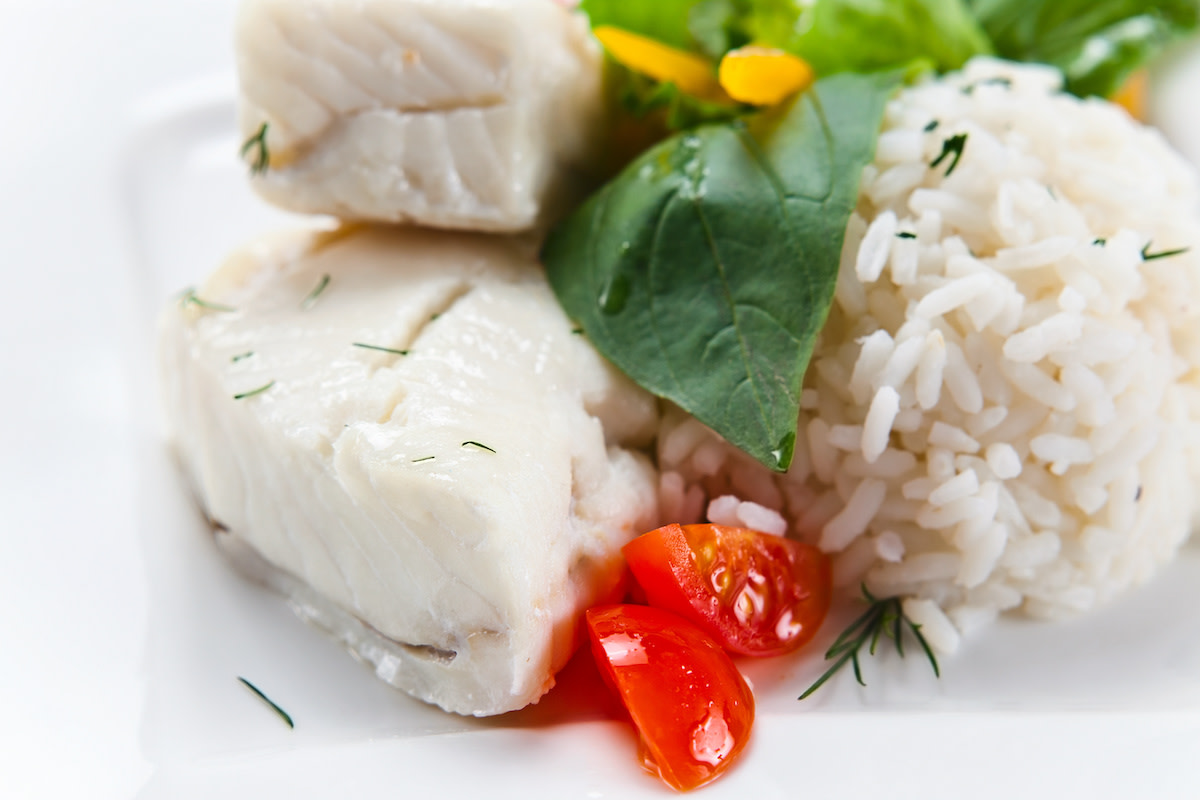Poached Halibut Recipe: How to Poach Halibut 6 Ways
Written by MasterClass
Last updated: Nov 26, 2024 • 4 min read
Poaching halibut keeps this delicate white fish juicy and creates a flavorful broth or base for a sauce. Learn how to make poached halibut at home for a quick weeknight meal.
Learn From the Best
What Is Halibut?
Halibut are right-handed flatfish—fish that live on the ocean floor and have both of their eyes (and their viscera) on their right sides. Pacific halibut (Hippoglossus stenolepis) is the most commercially available option, weighing up to sixty pounds and often sold as skinless steaks. Pacific halibut is a sustainable seafood choice between March and September: When shopping for the fish, look for firm-textured flesh that’s translucent and sparkly.
Halibut has a mild, sweet flavor, with firm-textured white flesh that becomes opaque when cooked. It pairs equally well with lemon and butter or tangy, deeply spiced East Asian–inspired broths. Poaching is an ideal preparation for retaining the fish’s moisture. Like simmering and boiling, poaching involves submerging food in liquid—perfect for this delicate fish. (Those new to poaching can warm up by learning how to poach an egg with Chef Gordon Ramsay.
4 Tips for Poaching Halibut
Poaching is one of the fastest, most straightforward techniques for cooking fish. Here’s what you need to know:
- 1. Use low heat. Poaching is a gentle cooking process; the trick is to keep the liquid at a low temperature–just below the boiling point. Keeping the poaching liquid at a low simmer will prevent overcooking the fish.
- 2. Cover the fish while it cooks. Keeping the lid on the pot while poaching helps you cook the halibut evenly. Remove the lid as needed to check for doneness.
- 3. Watch the time. Simmer the fish for about five to ten minutes, depending on its thickness. If you have a digital instant-read thermometer, use it to check for doneness. The ideal internal temperature for halibut is 130–135 degrees Fahrenheit.
- 4. Season to taste. Instead of poaching the fish in water, build a flavorful poaching base that will infuse your halibut with flavor—and serve it as a delicious sauce. Try adding an acid (such as vinegar, lemon juice, or wine) and aromatics, perhaps in the form of a bouquet garni made with herbs like bay leaves, thyme, and rosemary.
6 Ways to Make Poached Halibut
Cooking halibut in a flavorful poaching liquid results in an easy one-pan pescatarian dinner. Here are some ideas:
- 1. Japanese-inspired poached halibut: Channel Japanese flavors by poaching halibut in dashi broth seasoned with grated fresh ginger, grated garlic, soy sauce, mirin, a tablespoon of miso paste, and a teaspoon of sugar. Add quartered baby bok choy to the dashi for a one-pot meal.
- 2. Mediterranean poached halibut: Add capers, grated garlic, and fresh lemon juice to your poaching liquid for Mediterranean halibut. Garnish the steaks with chopped fresh parsley.
- 3. Middle Eastern–style poached halibut: Add chopped preserved lemon, thinly sliced red onion, dried oregano, and Aleppo pepper or hot chili flakes to chicken stock or water for a halibut full of Middle Eastern flavors.
- 4. Olive oil–poached halibut: You may associate poaching with water, but cooking food in a large quantity of oil at a low temperature is another type of poaching. Also known as confit, this technique is perfect for flaky white fish like halibut. Add a few whole peppercorns, thinly sliced shallots, and thyme sprigs to a sauté pan with a cup of extra-virgin olive oil. The oil never goes above a simmer, so it avoids that acrid, hot oil smell and will be perfectly fine to reuse. Store the poaching oil in a jar and use it for sautéing future fish meals, eggs, or vegetables, or as a dressing in tuna Niçoise salad.
- 5. Saffron-poached halibut: Saffron infuses the poaching liquid with a beautiful orange color and earthy flavor. Dissolve the saffron threads in chicken broth, then add fresh lime or orange juice for acidity. Garnish the fish with fresh dill and mint and serve with Chef Yotam Ottolenghi’s celebratory saffron rice for a Persian-inspired feast.
- 6. Thai-style poached halibut: Combine coconut milk, fish sauce, chopped scallions, lime juice, and rice vinegar for a Thai-inspired broth. Garnish the fish with tender fresh herbs like cilantro, mint, and Thai basil.
Tomato-Poached Halibut Recipe
makes
prep time
5 mintotal time
20 mincook time
15 minIngredients
- 1
Pat the halibut steaks dry with paper towels and season all over with salt and pepper. Set them aside.
- 2
In a wide, shallow pan over medium heat, combine the tomatoes, garlic, thyme, and wine.
- 3
Keep the mixture over medium heat until bubbles form along the edges of the pan, the garlic and wine become fragrant, and the tomatoes start to break down.
- 4
Turn the heat down to low.
- 5
Gently lower the fish into the poaching liquid and cover.
- 6
Cook the fish, covered, until the flesh turns opaque and the internal temperature reaches 130–135 degrees Fahrenheit, about 5–10 minutes.
- 7
Using a fish spatula, gently transfer the cooked steaks to 4 serving bowls and let them rest at room temperature.
- 8
Raise the heat to medium-high to reduce the poaching liquid down into a sauce.
- 9
After reducing the liquid by approximately one-third, remove the thyme sprigs and the pan from the heat.
- 10
Add the butter, if using, and whisk until emulsified.
- 11
Spoon the sauce over the fish and garnish it with fresh herbs.
Become a better chef with the MasterClass Annual Membership. Gain access to exclusive video lessons taught by the world’s best, including Gordon Ramsay, Gabriela Cámara, Chef Thomas Keller, Dominique Ansel, Yotam Ottolenghi, Alice Waters, and more.
